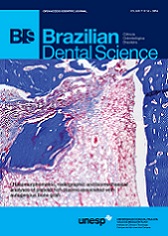Bonding to bleached enamel treated with 10% sodium bicarbonate: a one-year follow-up
DOI:
https://doi.org/10.14295/bds.2014.v17i4.1046Resumo
Objective. This article is a brief review about in vitro proposals to overcome the low bond strength values to bleached dental surfaces through a one-year follow-up case report of the immediate replacement of composite resin restorations after enamel bleaching. Clinical considerations. The presence of residual oxygen after bleaching may be responsible for inhibiting the polymerization of the monomers present in the adhesive systems, leading to the failure of the restorative procedure. The use of antioxidants, especially the 10% sodium bicarbonate solution (SB), could be a fast and practical alternative to improve the bond strength of these restorations. In office bleaching with hydrogen peroxide 35% (Lase Peroxide Sense, DMC, Ribeirão Preto, SP, BRA) was performed followed by the removal of the unsatisfactory restorations. Then, the BS was applied and the new adhesive restorations were placed. After one year, the clinical performance of the restorations were successful, showing no signs of failure nor infiltration. Conclusions. The use of the 10% sodium bicarbonate in bleached enamel seems to be a viable alternative for clinical practice.
Downloads
Downloads
Arquivos adicionais
Publicado
Como Citar
Edição
Seção
Licença
TRANSFERÊNCIA DE DIREITOS AUTORAIS E DECLARAÇÃO DE RESPONSABILIDADE
Toda a propriedade de direitos autorais do artigo "____________________________________________________________________" é transferido do autor(es) para a CIÊNCIA ODONTOLÓGICA BRASILEIRA, no caso do trabalho ser publicado. O artigo não foi publicado em outro lugar e não foi submetido simultaneamente para publicação em outra revista.
Vimos por meio deste, atestar que trabalho é original e não apresenta dados manipulados, fraude ou plágio. Fizemos contribuição científica significativa para o estudo e estamos cientes dos dados apresentados e de acordo com a versão final do artigo. Assumimos total responsabilidade pelos aspectos éticos do estudo.
Este texto deve ser impresso e assinado por todos os autores. A versão digitalizada deverá ser apresentada como arquivo suplementar durante o processo de submissão.




























